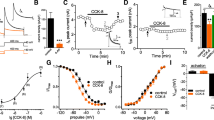Abstract
Three distinct classes of protein kinases have been shown to regulate Ca2+ current in excitable tissues. Cyclic AMP-dependent protein kinase mediates the action of noradrenaline on the Ca2+ current of cardiac muscle cells1,2. Cyclic GMP-dependent protein kinase mediates the serotonin-induced modulation of the Ca2+ current in identified snail neurons3. The Ca2+/diacylglycerol-dependent protein kinase (protein kinase C) has also been found to regulate Ca2+ currents of neurons4,5. However, no neurotrans-mitter has yet been shown to regulate Ca2+current through the activation of protein kinase C. We now report that cholecystokinin, a widely occurring neuropeptide6 which is present in molluscan neurons7,8, modulates the Ca2+ current in identified neurons9 of the snail Helix aspersa, and that this effect appears to be mediated by protein kinase C. Specifically, sulphated cholecystokinin octapeptide 26–33 (CCK8), activators of protein kinase C, and intracellular injection of protein kinase C, all shorten the Ca2+-dependent action potential and decrease the amplitude of the Ca2+ current in these cells. All these effects are not reversible within the duration of the experiments. Moreover, intracellular injections of low concentrations of protein kinase C, which are ineffective by themselves, enhance the effectiveness of low concentrations of CCK8 on the Ca2+current.
Similar content being viewed by others

References
Osterrieder, W. et al. Nature 298, 576–578 (1982).
Brum, G., Flockerzi, V., Hofman, F., Osterrieder, W. & Trautwein, W. Pflügers Arch. ges. Physiol. 398, 146–154 (1983).
Paupardin-Tritsch, D., Hammond, C., Gerschenfeld, H. M., Nairn, A. C. & Greengard, P. Nature 323, 812–814 (1986).
DeRiemer, S. A., Strong, J. A., Albert, K. A., Greengard, P. & Kaczmarek, L. K. Nature 313, 313–316 (1985).
Rane, S. G. & Dunlap, K. Proc. natn. Acad. Sci. U.S.A. 83, 184–188 (1986).
Crawley, J. N. Ann. N.Y. Acad. Sci. 448, 1–8 (1985).
Osborne, N. N., Cuello, A. C. & Dockray, C. G. Science 216, 409–411 (1982).
Ono, J. K. Neuroscience 18, 957–974 (1986).
Kerkut, G. A., Lambert, J. C. D., Gayton, R. J., Loker, J. E. & Walker, R. J. Comp. Biochem. Physiol. 50A, 1–25 (1975).
Tillotson, D. Proc. natn. Acad. Sci. U.S.A. 76, 1497–1500 (1979).
Berridge, M. J. Biochem. J. 220, 345–360 (1984).
Nishizuka, Y. Science 225, 1365–1370 (1984).
Sankaran, H., Goldfine, I. D., Deveney, C. W., Wong, K-Y. & Williams, J. A. J. biol. Chem. 255, 1849–1853 (1980).
Williams, J. A., Vigna, S. R., Sakamoto, C. & Goldfine, I. D. Ann. N.Y. Acad. Sci. 448, 220–230 (1985).
Paupardin-Tritsch, D., Colombaioni, L., Deterre, P. & Gerschenfeld, H. M. J. Neurosci. 5, 2522–2532 (1985).
Strong, J. A., Fox, A. P., Tsien, R. W. & Kaczmarek, L. K. Biophys. J. 49, 430a (1986).
Farley, J. & Auerbach, S. Nature 319, 220–223 (1986).
Madison, D. V., Malenka, R. C. & Nicoll, R. A. Nature 321, 695–697 (1986).
Higashida, H. & Brown, D. A. Nature 323, 333–335 (1986).
Dodd, J. & Kelly, J. S. Brain Res. 205, 337–350 (1981).
Brooks, P. A. & Kelly, J. S. Ann. N.Y. Acad. Sci. 448, 361–374 (1985).
Willets, J., Urban, I., Murase, K. & Randic, M. Ann. N.Y. Acad. Sci. 448, 385–401 (1985).
Kikkawa, U., Takai, Y., Minakuchi, R., Inohara, S. & Nishizuka, Y. J. biol. Chem. 257, 13341–13348 (1982).
Author information
Authors and Affiliations
Rights and permissions
About this article
Cite this article
Hammond, C., Paupardin-Tritsch, D., Nairn, A. et al. Cholecystokinin induces a decrease in Ca2+ current in snail neurons that appears to be mediated by protein kinase C. Nature 325, 809–811 (1987). https://doi.org/10.1038/325809a0
Received:
Accepted:
Issue Date:
DOI: https://doi.org/10.1038/325809a0
- Springer Nature Limited
This article is cited by
-
The regulation of neurotransmitter secretion by protein kinase C
Molecular Neurobiology (1998)
-
Trifluoperazine enhancement of Ca2+-dependent inactivation of L-type Ca2+ currents inHelix aspersa neurons
Invertebrate Neuroscience (1998)
-
Development of the concepts on voltage-operated calcium channels
Neurophysiology (1997)
-
Voltage gated calcium channels in molluscs: classification, Ca2+ dependent inactivation, modulation and functional roles
Invertebrate Neuroscience (1996)
-
Effects of serotonin and cAMP on calcium currents in different neurones of Helix pomatia
Pfl�gers Archiv European Journal of Physiology (1992)




